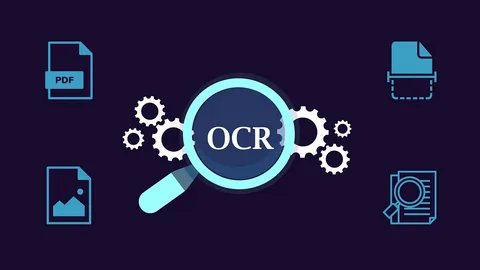In the current data-driven world, businesses are inundated with vast amounts of information, often stored in complex document formats. Traditional Optical Character Recognition (OCR) has been a game-changer in converting these documents into editable and searchable formats. However, the integration of Artificial Intelligence (AI) into OCR technology has taken its capabilities to an entirely new level, significantly improving its accuracy and efficiency.
Market trends further underscore the momentum behind this technological shift. The AI-based OCR market is projected to grow from $11.369 billion in 2025 to $23.456 billion by 2030, reflecting a compound annual growth rate (CAGR) of 15.59%. This growth highlights how essential AI-powered OCR has become for handling complex document structures across industries.
This article explores how AI enhances OCR accuracy, particularly for complex document structures, and the significant benefits this brings to various sectors.
Understanding OCR and Its Evolution
OCR technology has been around since the early 1990s, serving as a vital tool for organizations managing large volumes of documents. Initially, OCR was limited to recognizing printed text, but advancements in AI have transformed it into an efficient solution capable of handling more complex tasks.
Key Features of Traditional OCR:
- Text Recognition: Converts printed text into machine-readable formats.
- Basic Processing: Primarily focuses on simple layouts and clear fonts.
While traditional OCR has its merits, it struggles with complex documents that feature varied layouts, fonts, and even handwritten text. This is where AI steps in, making OCR not just a scanning tool but a comprehensive document analysis solution.
Now that we’ve explored the roots of OCR technology, let’s see how AI is revolutionizing its accuracy and performance.
The Role of AI in Enhancing OCR Accuracy
AI OCR software uses advanced machine learning algorithms and neural networks to improve recognition accuracy. By analyzing large datasets, these systems learn to identify patterns and adapt to various document formats, significantly enhancing their performance.
1. Machine Learning Algorithms
Machine learning algorithms enable OCR systems to learn from previous data, refining their ability to recognize characters and words. This dynamic learning process allows for continuous improvement, resulting in higher accuracy rates across different document types.
2. Neural Networks and Deep Learning
Neural networks, particularly deep learning models, are instrumental in processing complex documents. These models can analyze complex patterns in text, making them effective for recognizing handwritten content and diverse fonts.
3. Enhanced Contextual Understanding
AI-powered OCR goes beyond mere character recognition. By utilizing Natural Language Processing (NLP), these systems can understand the context of the text, improving their ability to extract relevant information accurately.
With the foundational technology covered, it’s time to examine the tangible benefits that AI-enhanced OCR offers businesses.
Advantages of AI-Enhanced OCR
The integration of AI into OCR technology offers several advantages, particularly for businesses dealing with complex document structures.
1. Improved Accuracy
One of the most important benefits of AI-enhanced OCR is its ability to achieve accuracy levels that often surpass human performance. This is especially true for challenging tasks like handwritten text recognition and document analysis.
2. Faster Processing Speeds
AI-powered OCR systems can process documents at great speeds. This efficiency allows businesses to digitize and analyze large volumes of documents in real-time, accelerating workflows and improving operational effectiveness.
3. Handling Complex Documents
AI-enhanced OCR excels in managing documents with diverse layouts, fonts, and formatting styles. Be it invoices, legal contracts, or handwritten notes, these systems can accurately extract data from various document types, regardless of their complexity.
4. Advanced Document Analysis
Beyond text recognition, AI-powered OCR systems can perform advanced document analysis. By utilizing NLP techniques, these systems can extract key information from unstructured documents, providing businesses with valuable insights and facilitating automated decision-making processes.
To understand the real-world value of AI-enhanced OCR, let’s explore how it is being used across various industries.
Practical Applications of AI-Enhanced OCR Technology
The advancements in AI-powered OCR technology have opened the door to a wide range of practical applications across various industries.
1. Document Digitization and Archiving
Businesses can utilize AI-enhanced OCR to digitize and archive paper-based documents, such as invoices and contracts, with remarkable accuracy. This capability streamlines document storage and retrieval processes, reducing manual effort and improving productivity. It integrates with systems like SAP, Oracle, and Microsoft Dynamics, making it ideal for large enterprises handling high volumes of complex documents.
2. Data Extraction and Analysis
AI-driven OCR technology allows organizations to extract valuable data from documents and analyze it for actionable insights. This can include anything from financial data extraction to analyzing customer feedback from surveys.
3. Automating Document Workflows
AI-powered OCR can automate document workflows by intelligently routing documents, extracting relevant information, and triggering actions based on predefined rules. This reduces manual errors and enhances operational efficiency.
4. Enhancing Accessibility
AI-enhanced OCR plays a crucial role in improving accessibility for individuals with disabilities. By converting printed text into accessible digital formats, such as audio files or Braille documents, these systems enable individuals with visual impairments to access and interact with documents more effectively.
5. Regulatory Compliance
AI-powered OCR assists businesses in maintaining compliance with regulatory requirements by automating document management processes and facilitating audit trails. This ensures that organizations can uphold accurate records and safeguard sensitive information.
As you consider adopting AI-powered OCR in your organization, it’s important to approach implementation with a well-defined strategy.
Implementing AI-Powered OCR Solutions: Best Practices
While AI-powered OCR technology offers immense potential, effective implementation requires planning and execution. Here are some best practices to consider:
1. Define Clear Objectives and Requirements
Before adopting an AI-powered OCR solution, it’s essential to define your objectives and requirements. Identify the specific documents and processes that could benefit from OCR technology and establish clear goals for implementation.
2. Choose the Right Technology Partner
Selecting the right vendor is crucial for the success of your AI-powered OCR implementation. Look for partners with a proven track record of delivering reliable and scalable OCR solutions, considering their technology expertise and customer support capabilities.
3. Conduct Thorough Testing and Evaluation
Before deploying an AI-powered OCR solution, conduct extensive testing and evaluation to assess its accuracy and performance. Use sample documents to simulate different use cases and identify any potential issues or limitations.
4. Provide Adequate Training and Support
Ensure that your team receives sufficient training to utilize the AI-powered OCR solution effectively. Providing training sessions and documentation will familiarize users with the solution’s features and functionality.
5. Monitor Performance and Iterate
Once the AI-powered OCR solution is deployed, closely monitor its performance and gather user feedback to identify areas for improvement. Utilize analytics tools to track key metrics and optimize the system as needed.
Looking ahead, let’s explore the innovations that are shaping the next generation of OCR technology.
Future Trends in AI-Powered OCR
As technology continues to evolve, the future of AI-powered OCR looks promising. Here are some trends to watch for:
1. Enhanced Multilingual Support
Future AI-enhanced OCR systems are expected to support an even wider range of languages and character sets. This will enable businesses to process documents from diverse global contexts more efficiently.
2. Real-Time Processing
With advancements in hardware acceleration and parallel processing techniques, AI-powered OCR systems may soon be able to process documents in real time, further accelerating workflows and enhancing productivity.
3. Improved Handwriting Recognition
As AI research progresses, we can expect significant improvements in handwriting recognition capabilities. This will broaden the applicability of OCR technology across various industries.
3. Integration with Other AI Technologies
The future of AI-powered OCR may see deeper integration with other AI technologies, such as predictive analytics and machine learning, enabling even more sophisticated document analysis and data extraction capabilities.
Final Thoughts
The integration of AI into OCR technology represents a leap forward in document processing capabilities. By enhancing accuracy, speed, and functionality, AI-powered OCR systems like Docsumo are transforming how businesses manage and utilize their documents. With organizations continuing to embrace this technology, they can unlock new opportunities for efficiency, productivity, and innovation in their document management processes.
In a world where data is king, leveraging AI-enhanced OCR is not just a competitive advantage; it’s a necessity for businesses seeking to succeed in the digital age. By understanding the benefits and practical applications of AI-powered OCR technology, companies can position themselves to excel in a data-driven landscape.














